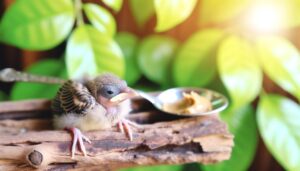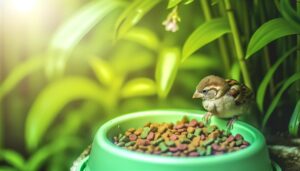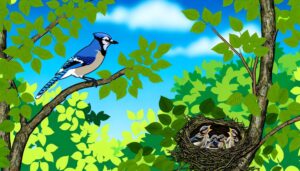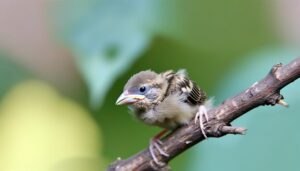Do You Know 5 Essential Steps to Save a Baby Sparrow?
First, observe the baby sparrow's environment and physical condition. Look for immediate dangers and visible injuries like broken wings.
Identify the bird's age by examining feather development and behavior. Keep the sparrow warm in a ventilated box with a heating pad, aiming for around 95°F.
Create a temporary nest using soft fabric while maintaining a stable temperature of 85-90°F. Check for injuries by inspecting wings, legs, beak, and eyes.
Gradual outdoor exposure and foraging practice help prepare for reintroduction to the wild. More about monitoring growth and seeking professional help will provide a thorough rescue process.
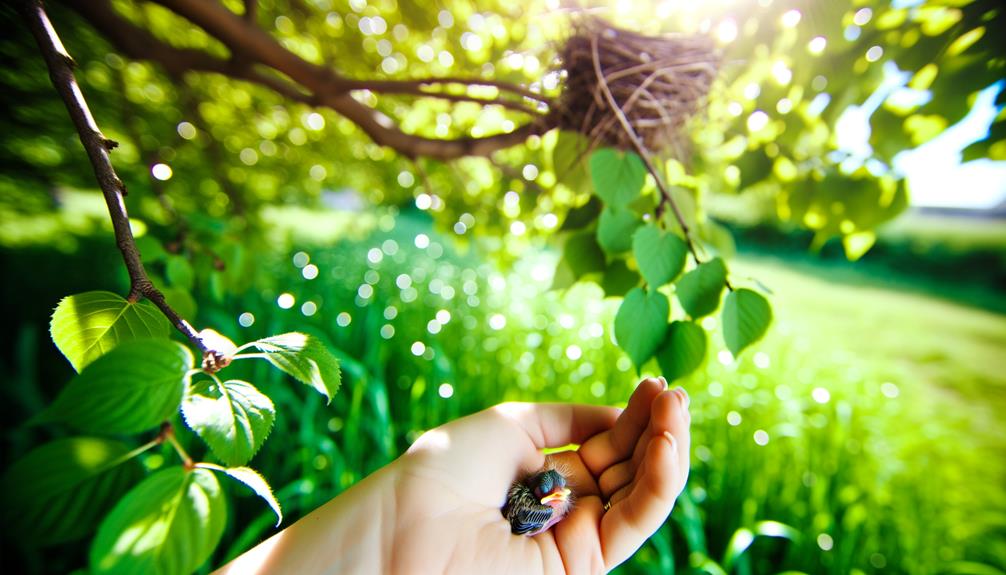
Key Takeaways
- Keep the sparrow warm using a ventilated box with soft cloth and a heating pad, aiming for a temperature of around 95°F (35°C).
- Check for injuries such as broken wings or bleeding and provide immediate care or consult a wildlife rehabilitator if needed.
- Assess the environment for immediate dangers like predators or harsh weather, and look for a nearby nest or parent birds.
- Prepare a temporary nest with soft fabric or paper towels in a calm area, maintaining an ambient temperature of 85-90°F.
- Feed the sparrow appropriately, using age-appropriate food and feeding techniques, ensuring it is hydrated and nourished.
Assess the Situation
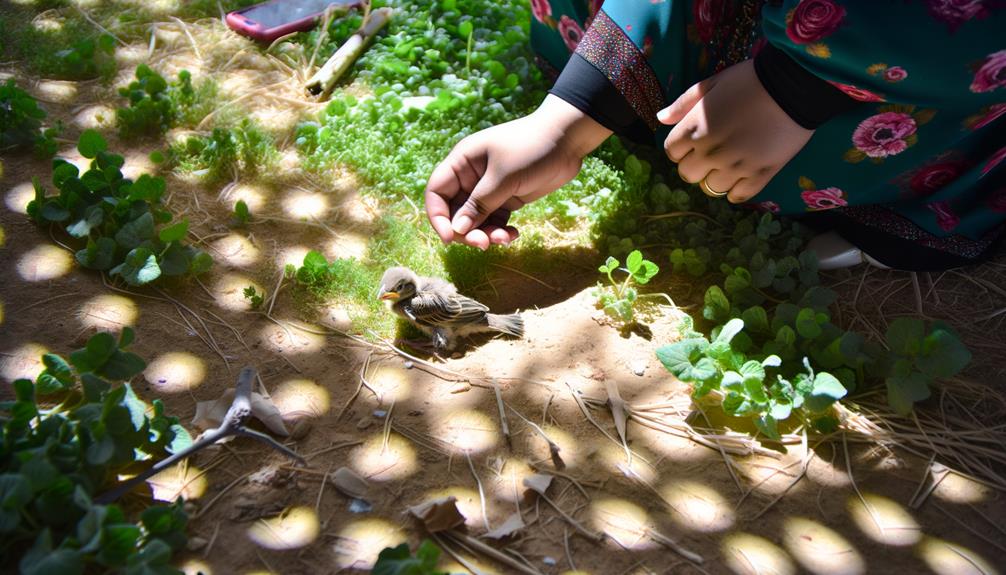
Before intervening, it's important to observe the baby sparrow's environment and physical condition to determine the best course of action.
First, note if the bird is in immediate danger from predators or harsh weather. Check for any visible injuries like broken wings or blood. If the bird appears to be healthy, look around for a nearby nest or parent birds. Sparrows often leave their nests temporarily while learning to fly. Research indicates that fledglings are safer left alone unless in direct peril.
Additionally, observe the bird's behavior— are its eyes open, is it making noise, or is it lethargic? Each of these observations can provide critical data to guide your next steps in effectively aiding the baby sparrow.
Identify the Sparrow's Age
Determining the age of a baby sparrow involves meticulous observation of its physical characteristics and developmental stages. First, examine the feathers. Hatchlings, typically 0-3 days old, have closed eyes and sparse, downy feathers. By day 4-6, the eyes begin to open, and pin feathers emerge. At 7-10 days, the eyes are fully open, and feathers start to unfurl.
Nestlings, aged 11-14 days, exhibit more defined feathers and attempt short flights. Fledglings, around 15-17 days old, are mostly feathered and actively exploring their surroundings. Pay attention to size, beak color, and vocalization patterns, as these indicators also refine age estimation. Accurately identifying the age informs appropriate care strategies, ensuring you meet the sparrow's specific developmental needs effectively.
Check for Injuries
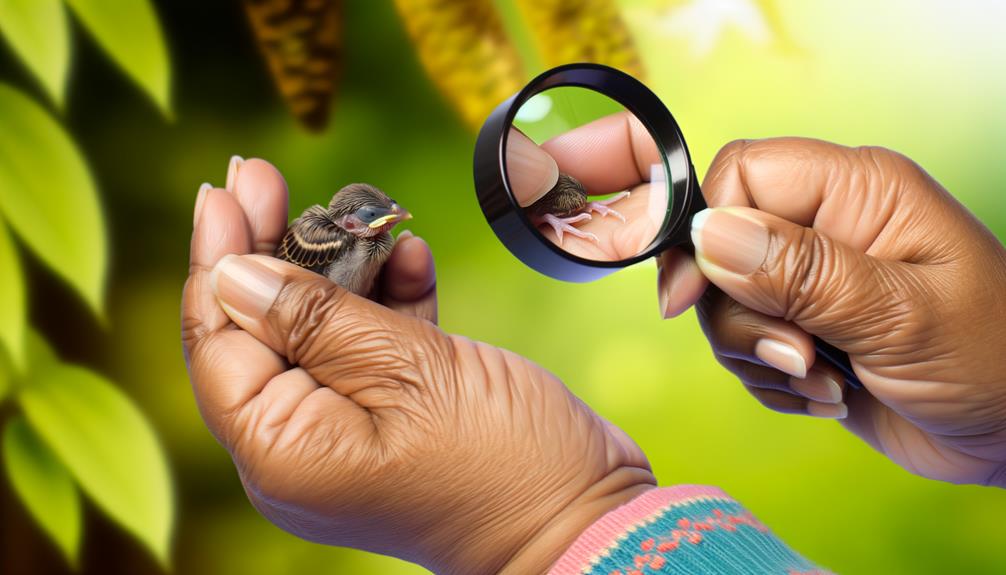
Once you've accurately determined the age of the baby sparrow, conduct a thorough inspection for any visible injuries or abnormalities.
Begin by gently observing the sparrow's wings, legs, and beak for fractures, dislocations, or deformities. Check for signs of bleeding, swelling, or unusual coloration indicative of infection.
Examine the eyes for clarity; any cloudiness or discharge may signal health issues. Listen closely for any respiratory distress, such as wheezing or labored breathing.
Gently palpate the body to detect any internal injuries or abnormalities. If you identify any injury or suspect illness, consult a wildlife rehabilitator immediately.
Prompt and meticulous evaluation ensures that the sparrow receives appropriate care and increases its chances of recovery.
Keep the Sparrow Warm
Maintaining an ideal temperature is vital for a baby sparrow's survival, as they're particularly vulnerable to cold stress. Research indicates that young sparrows can't regulate their body temperature efficiently.
First, use a small, ventilated box lined with soft cloth. Position a heating pad set on low beneath half of the box, allowing the sparrow to move if it gets too warm. Alternatively, a warm, uncooked rice sock can provide necessary warmth.
Monitor the temperature closely, aiming for 95°F (35°C). Observing the sparrow's behavior can help; if it's huddled and fluffed up, it's likely too cold, whereas panting indicates overheating.
Ensuring a stable, warm environment is pivotal for the bird's immediate well-being and recovery.
Prepare a Temporary Nest
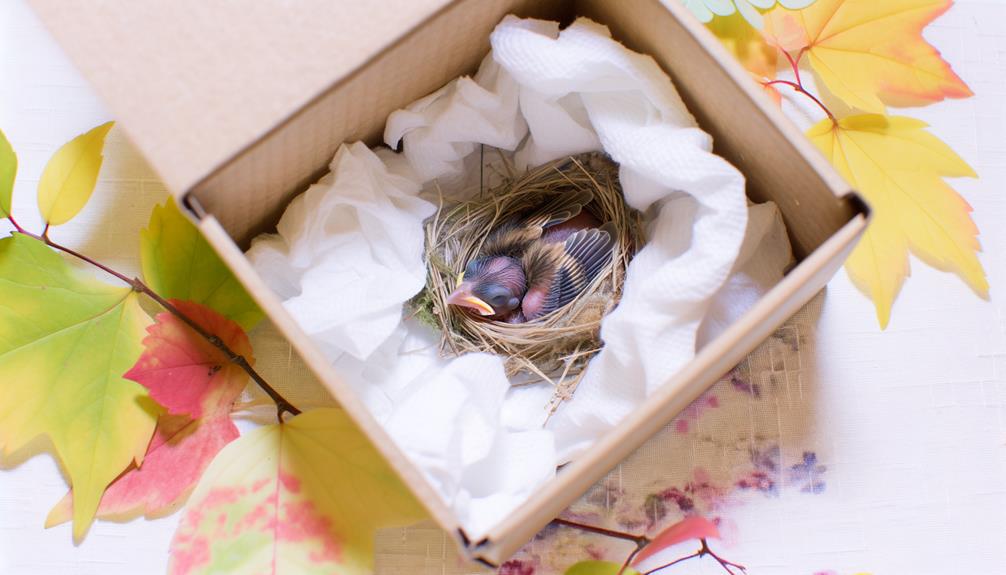
To create a temporary shelter, use a small, shallow receptacle lined with soft fabric or paper towels, confirming the materials are clean and free from any harmful chemicals. Place the receptacle in a calm, cozy area away from direct sunlight and drafts.
Research indicates that maintaining an ambient temperature of 85-90°F is essential for the sparrow's survival. Monitor the shelter regularly to make sure it remains clean and dry, replacing the lining as needed to prevent bacterial growth.
Use a receptacle with low sides to facilitate airflow and mimic the natural habitat. Avoid using materials like cotton wool, which can entangle the bird's delicate limbs.
Your meticulous preparation will provide a safe, nurturing space, aiding the baby sparrow's recovery and growth.
Feeding the Baby Sparrow
After setting up an appropriate temporary nest, you should focus on providing a suitable diet for the baby sparrow to guarantee its proper nutrition and growth.
Baby sparrows require a protein-rich diet similar to what they'd receive from their parents. You can prepare a mixture of soaked dog or cat kibble, hard-boiled eggs, and mealworms. Make sure the food is soft and easy to swallow.
Feed the baby sparrow every 15-20 minutes from dawn until dusk using a small, blunt-tipped syringe or tweezers. Monitor the bird's weight and growth closely, adjusting the diet as necessary.
Avoid feeding bread, milk, or seeds, as these can cause nutritional deficiencies and health issues. Always prioritize the bird's well-being and consult an avian veterinarian if needed.
Hydration Needs
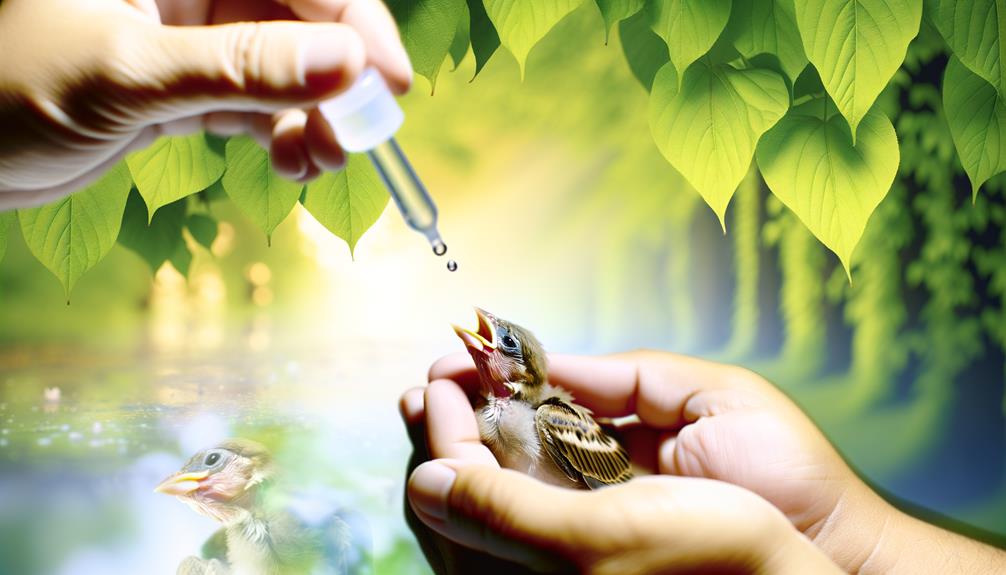
Ensuring proper hydration is crucial for the survival and development of a baby sparrow, as it greatly impacts their metabolic functions and overall health.
You should use a dropper or syringe to provide small amounts of water, carefully placing drops at the edge of the beak. Avoid forcing water directly into the throat to prevent aspiration.
Research indicates that hydration should be administered every 30-60 minutes, particularly in warm environments where dehydration risks are higher.
You might also consider using electrolyte solutions designed for birds, which help maintain fluid balance and support essential functions.
Observing the baby's behavior and physical condition will guide you in adjusting hydration frequency and volume, ensuring the fledgling remains healthy and thrives.
Monitor Growth and Health
You should conduct regular weight checks to guarantee the baby sparrow's growth aligns with established norms.
Carefully observe feather development stages, noting any deviations from typical patterns.
Track behavioral milestones, such as feeding responses and mobility, to assess overall health and progress.
Regular Weight Checks
Regular weight checks are important for monitoring a baby sparrow's growth and overall health, ensuring it gains weight steadily and develops properly. You should weigh the sparrow daily at the same time to maintain consistency. Use a precise digital scale that measures in grams. Record each weight to track trends over time.
A healthy increase in weight suggests proper nutrition and care. If the sparrow's weight plateaus or decreases, this could indicate health issues requiring immediate attention. Consult avian care guides and veterinarians for target weight ranges based on the sparrow's age and species.
Feather Development Stages
Tracking the feather development stages of a baby sparrow offers critical insights into its health and growth trajectory. Observing these stages allows you to monitor its progress and make informed decisions about its care.
Here are the key stages to watch:
- Pin Feathers: Initially, you'll see pin feathers, which are short and encased in a keratin sheath.
- Shedding Sheaths: Next, the sparrow will shed these sheaths, revealing the emerging feathers.
- Feather Expansion: Feathers then expand and fill out, providing insulation and protection.
- Flight Readiness: Finally, fully developed flight feathers indicate readiness for independent survival.
Consistent observation ensures the sparrow is developing normally and allows you to intervene if any issues arise.
Behavioral Milestones Tracking
Behavioral milestones provide an essential framework for evaluating the growth and health of a baby sparrow. This framework focuses on specific actions like feeding responses, social interactions, and flight attempts.
Monitor feeding responses by observing if the sparrow opens its beak widely and chirps actively for food, indicating a healthy appetite.
Social interactions can be tracked by noting how the sparrow responds to your presence and other birds. This behavior shows signs of bonding and communication.
Flight attempts are vital. You should see progressive wing flapping and short hops, leading to sustained flights.
Document these behaviors consistently to make sure the sparrow's development aligns with expected milestones. Use research-based guidelines to support your observations and interventions.
Introducing to the Wild
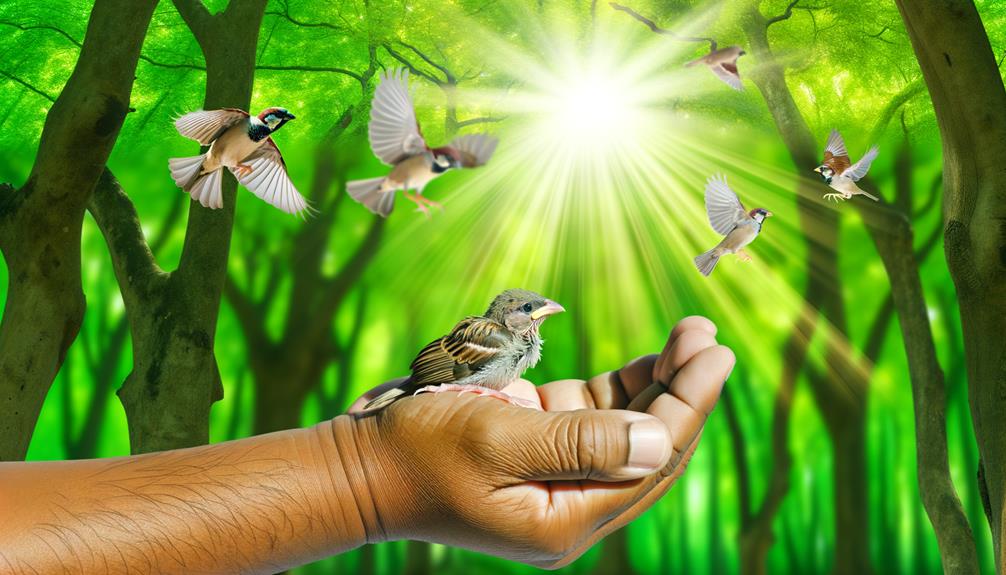
To successfully reintroduce a baby sparrow to the wild, you should start with gradual environment exposure to acclimate it to outdoor conditions.
Encourage natural foraging skills by providing opportunities for the sparrow to find its own food.
Additionally, implement predator awareness training to enhance its survival instincts against common threats.
Gradual Environment Exposure
Introducing a rescued baby sparrow to the wild should be a gradual process, starting with short, supervised outings into a safe, enclosed outdoor area to acclimate the bird to its natural environment. Carefully monitor the sparrow's reactions and behavior during these initial exposures.
To guarantee a smooth adjustment, follow these steps:
- Observation: Watch for signs of stress or discomfort, such as rapid breathing or frantic movements.
- Duration: Gradually increase the length of time spent outside, starting with 10-15 minute sessions.
- Shelter: Provide access to shelter, like small bushes or a birdhouse, to offer a sense of security.
- Predator Awareness: Stay vigilant for potential threats, such as cats or larger birds, to protect the sparrow during this vulnerable phase.
Natural Foraging Skills
After the sparrow becomes comfortable with the outdoor surroundings, the next step involves promoting its innate foraging abilities to make certain it can independently locate food in the wild.
Begin by placing small amounts of seeds and insects in different spots within the sparrow's reachable habitat. Gradually decrease human involvement to motivate the bird to search for food on its own.
Observational studies suggest that sparrows learn foraging behaviors through repetition and exploring their environment. Monitor the sparrow's progress closely, noting its capability to identify and capture various food sources.
Documentation of these behaviors will offer valuable insights into its readiness for full release. Your role is to guarantee the sparrow masters these skills, enabling a successful shift back into its natural ecosystem.
Predator Awareness Training
Effective predator awareness training is essential for ensuring the sparrow's survival once released into the wild. You'll need to simulate various predators and teach the sparrow to recognize danger. Research indicates that sparrows learn best through repetitive exposure and immediate response training.
Here are four steps to take into account:
- Visual Cues: Use models of common predators like hawks and cats to help the sparrow identify threats.
- Auditory Signals: Play recordings of predator calls and associated alarm calls from other birds.
- Flight Drills: Practice sudden flight maneuvers to simulate escape from predators.
- Environmental Exposure: Gradually introduce the sparrow to natural settings where predators are present.
When to Seek Professional Help
When the baby sparrow shows signs of severe injury, illness, or malnutrition, it's important to seek professional help from a licensed wildlife rehabilitator immediately. Look for symptoms like labored breathing, unresponsiveness, broken limbs, or visible wounds.
Additionally, be alert to signs of malnutrition such as weakness, lethargy, or prominent keel bones. Research indicates that prompt intervention by professionals increases the survival rate for distressed fledglings.
Contact local wildlife rehabilitation centers or veterinarians specializing in avian care. They possess the expertise and resources to provide necessary medical treatment and rehabilitation. Don't attempt complex medical procedures on your own; improper care can worsen the bird's condition.
Prioritize the sparrow's well-being by involving trained professionals early on.
Conclusion
In your efforts to save a baby sparrow, remember that successful rehabilitation is essential. Research shows that about 80% of hand-reared sparrows can be reintroduced to the wild.
By evaluating the situation, keeping the bird warm, providing proper hydration, and monitoring its health, you can greatly increase its chances of survival. However, always be prepared to seek professional assistance if needed, ensuring that your feathered friend is given the best opportunity to thrive in its natural habitat.

